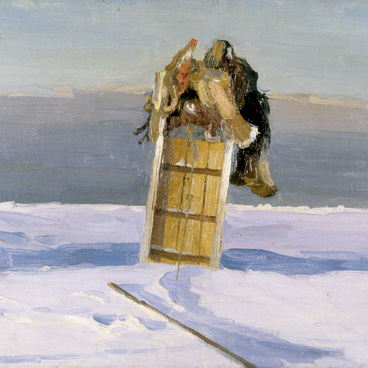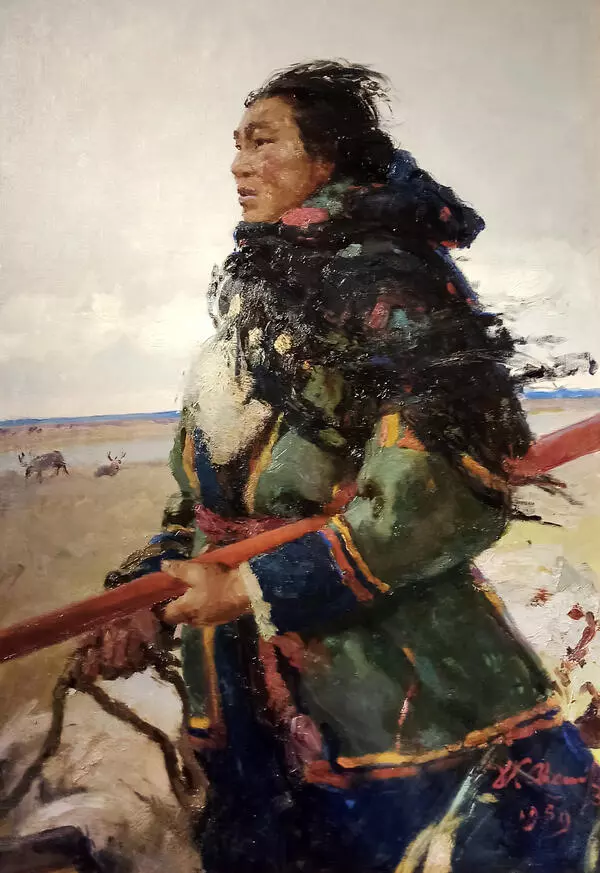Dmitry Konstantinovich Sveshnikov was a famous Soviet painter, a People’s Artist of the RSFSR, a Corresponding Member of the Academy of Arts and the first honorary citizen of Naryan-Mar.
This is what he wrote about arctic lands: “The power of the North… This phrasing has different meaning for different people. But I learned by experience that it is quite accurate. I spent the war here working. I visited and explored many places, I learned about the people that live here and came to love them. And when the war was over, I decided to stay here forever.”
For the artist, it was difficult to adapt in the Far North. What for the Nenets people was an everyday activity, for Sveshnikov seemed like a fight for life: “Once, there was a moment when I thought that it was all over, that we will never get out of the tundra alive. We were supposed to get to the camping in four hours, but we had spent about twenty-four hours trying to find it, we had lost half of our reindeer and had to abandon one of the sleds. It was dark, it was drizzling, we were chilled to the bone. And no sight of any settlement…” When the artist finally managed to get to the camping and told this story to the reindeer herders, they just laughed in response. For them, it was an insignificant event. Well, you roamed around a little, no big deal. All those new experiences excited Sveshnikov and stimulated his artistic imagination.
There, in the tundra, he found his protagonist, his subject, and he stayed true to that subject throughout his life. His artistic method was based on thorough studies of the Nenets way of life, their culture, customs and national character.
Before creating a serious work of art, Sveshnikov used to paint a lot of open-air studies and draw some sketches to explore the details of the future picture. Those studies and sketches were not intended to build a solid composition, they were just some visual impressions, a kind of travel notes from the tundra. Sveshnikov has visited southern countries, too, but he admitted that the studies he had painted there could not compete with the “northern” ones: “It makes every sense, ” the artist told. “There is a big difference between the South and the North. In the South, everything is devoured by the scorching sun. What a far cry from the northern landscape! Take the dwarf birches alone! And what vivid and rich and lucid colours you encounter in the tundra! They paint themselves on the canvas with an ease.”
This is what he wrote about arctic lands: “The power of the North… This phrasing has different meaning for different people. But I learned by experience that it is quite accurate. I spent the war here working. I visited and explored many places, I learned about the people that live here and came to love them. And when the war was over, I decided to stay here forever.”
For the artist, it was difficult to adapt in the Far North. What for the Nenets people was an everyday activity, for Sveshnikov seemed like a fight for life: “Once, there was a moment when I thought that it was all over, that we will never get out of the tundra alive. We were supposed to get to the camping in four hours, but we had spent about twenty-four hours trying to find it, we had lost half of our reindeer and had to abandon one of the sleds. It was dark, it was drizzling, we were chilled to the bone. And no sight of any settlement…” When the artist finally managed to get to the camping and told this story to the reindeer herders, they just laughed in response. For them, it was an insignificant event. Well, you roamed around a little, no big deal. All those new experiences excited Sveshnikov and stimulated his artistic imagination.
There, in the tundra, he found his protagonist, his subject, and he stayed true to that subject throughout his life. His artistic method was based on thorough studies of the Nenets way of life, their culture, customs and national character.
Before creating a serious work of art, Sveshnikov used to paint a lot of open-air studies and draw some sketches to explore the details of the future picture. Those studies and sketches were not intended to build a solid composition, they were just some visual impressions, a kind of travel notes from the tundra. Sveshnikov has visited southern countries, too, but he admitted that the studies he had painted there could not compete with the “northern” ones: “It makes every sense, ” the artist told. “There is a big difference between the South and the North. In the South, everything is devoured by the scorching sun. What a far cry from the northern landscape! Take the dwarf birches alone! And what vivid and rich and lucid colours you encounter in the tundra! They paint themselves on the canvas with an ease.”




